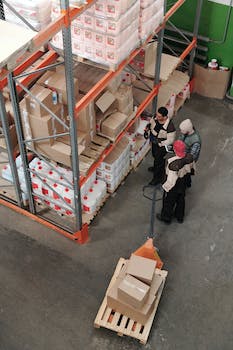

-
Table of Contents
"Stability and Safety: The Crucial Role of Ballast in Railway Tracks."
Introduction
The role of ballast in supporting railway tracks is crucial for the safe and efficient operation of trains. Ballast refers to the layer of crushed stones or rocks that is placed underneath and around the railway tracks. It serves several important functions, including providing stability, distributing loads, facilitating drainage, and reducing track deformation. Without proper ballast, railway tracks would be prone to instability, leading to derailments and other safety hazards. Therefore, the role of ballast in supporting railway tracks cannot be underestimated.
Importance of Ballast in Railway Track Stability
The stability of railway tracks is crucial for the safe and efficient operation of trains. One of the key elements that contribute to this stability is ballast. Ballast is a layer of crushed stones or rocks that is placed underneath the railway tracks. Its primary function is to distribute the load of the trains and provide a stable foundation for the tracks.
The importance of ballast in railway track stability cannot be overstated. Without proper ballast, the tracks would be prone to shifting and settling, leading to uneven surfaces and potential derailments. Ballast acts as a support system for the tracks, preventing them from sinking into the ground and maintaining their alignment.
One of the main reasons why ballast is essential is its ability to distribute the load of the trains. When a train passes over the tracks, it exerts a significant amount of force on the rails. Without ballast, this force would be concentrated in a small area, causing the tracks to sink into the ground. By spreading the load over a larger area, ballast helps to reduce the pressure on the tracks and prevent them from deforming.
In addition to load distribution, ballast also plays a crucial role in drainage. Railway tracks are exposed to various weather conditions, including rain and snow. If water is allowed to accumulate on the tracks, it can weaken the foundation and lead to instability. Ballast acts as a drainage layer, allowing water to flow through and away from the tracks. This helps to maintain the stability of the tracks and prevent water-related damage.
Another important function of ballast is to provide lateral resistance. Trains exert a significant amount of lateral force when they go around curves. Without proper lateral resistance, the tracks would be prone to shifting sideways, leading to misalignment and potential derailments. Ballast helps to counteract this lateral force by providing a stable foundation for the tracks to rest on.
Furthermore, ballast also helps to reduce vibrations and noise. Trains generate a considerable amount of vibrations as they travel along the tracks. Without ballast, these vibrations would be transmitted directly to the ground, causing discomfort to nearby residents and potentially damaging nearby structures. Ballast acts as a cushioning layer, absorbing and dissipating the vibrations, thereby reducing noise and ensuring a smoother ride for passengers.
In conclusion, the role of ballast in supporting railway tracks is of utmost importance. It provides load distribution, drainage, lateral resistance, and vibration reduction. Without ballast, the stability of the tracks would be compromised, leading to potential accidents and disruptions in train services. Therefore, it is crucial to ensure that ballast is properly installed and maintained to guarantee the safe and efficient operation of railway systems.
Types of Ballast Materials Used in Railway Tracks

The Role of Ballast in Supporting Railway Tracks
Railway tracks are a vital component of any transportation system, providing a safe and efficient means of transporting goods and people. However, the tracks themselves require a solid foundation to ensure their stability and longevity. This is where ballast comes into play.
Ballast is a layer of material that is placed between the railway ties and the underlying subgrade. Its primary function is to distribute the load of the trains evenly, providing stability and preventing the tracks from shifting or sinking into the ground. In addition, ballast also helps to drain water away from the tracks, reducing the risk of damage caused by moisture.
There are several types of ballast materials that are commonly used in railway tracks. One of the most widely used materials is crushed stone. This type of ballast is made by crushing rocks into small, angular pieces. Crushed stone ballast is known for its durability and strength, making it an excellent choice for supporting heavy loads. It also provides good drainage properties, allowing water to flow freely through the ballast layer.
Another commonly used material is gravel. Gravel ballast is made up of small, rounded stones that are typically found in riverbeds or quarries. It is less durable than crushed stone ballast but still provides adequate support for the tracks. Gravel ballast is often used in areas where crushed stone is not readily available or where cost is a factor.
Sand is another type of ballast material that is sometimes used in railway tracks. Sand ballast is made up of fine particles of sand that are compacted together. It is less stable than crushed stone or gravel ballast and is more prone to shifting under heavy loads. However, sand ballast is often used in areas where drainage is a concern, as it allows water to pass through easily.
In addition to these traditional ballast materials, there are also alternative options that are being explored. One such option is recycled materials, such as crushed concrete or asphalt. These materials are often used as a substitute for traditional ballast, as they are readily available and can help reduce waste. However, their long-term durability and performance are still being studied.
The choice of ballast material depends on several factors, including the type of trains that will be using the tracks, the expected loads, and the local conditions. For example, in areas with high rainfall, a ballast material with good drainage properties, such as crushed stone or gravel, may be preferred. On the other hand, in areas with limited resources or where cost is a concern, sand or recycled materials may be used.
In conclusion, ballast plays a crucial role in supporting railway tracks. It helps distribute the load of the trains evenly, provides stability, and prevents the tracks from sinking or shifting. There are several types of ballast materials that are commonly used, including crushed stone, gravel, and sand. The choice of ballast material depends on various factors, such as the expected loads and local conditions. As technology and research continue to advance, new and innovative ballast materials may be developed, further improving the performance and longevity of railway tracks.
Maintenance and Upkeep of Ballast for Efficient Railway Operations
The maintenance and upkeep of ballast is crucial for efficient railway operations. Ballast plays a vital role in supporting railway tracks, providing stability and ensuring the safe movement of trains. This article will explore the significance of ballast and discuss the various maintenance practices that are necessary to keep it in optimal condition.
Firstly, let us understand the role of ballast in supporting railway tracks. Ballast is a layer of crushed stones or rocks that is placed beneath the railway tracks. It serves as a foundation, distributing the weight of the trains evenly and preventing the tracks from sinking into the ground. Without proper ballast, the tracks would be susceptible to deformation and instability, leading to derailments and accidents.
To maintain the ballast, regular inspections and maintenance practices are essential. One of the primary concerns is the presence of fouling materials, such as dust, dirt, and debris, which can accumulate over time. These materials can reduce the effectiveness of the ballast by clogging the spaces between the stones, preventing proper drainage and compromising stability. Therefore, it is crucial to regularly remove these fouling materials through cleaning and sweeping operations.
Another important aspect of ballast maintenance is tamping. Tamping involves the process of compacting the ballast to ensure its stability and prevent any movement of the tracks. Over time, due to the constant passage of trains, the ballast can become loose and settle, leading to track misalignment. Tamping helps to restore the proper alignment and firmness of the ballast, ensuring a smooth and safe ride for trains.
In addition to cleaning and tamping, drainage is a critical factor in maintaining the ballast. Proper drainage is necessary to prevent water from accumulating and saturating the ballast. Excessive moisture can weaken the ballast, causing it to lose its load-bearing capacity and leading to track instability. Therefore, regular inspections of drainage systems, such as ditches and culverts, are necessary to ensure that water is effectively drained away from the tracks.
Furthermore, ballast degradation is a common issue that needs to be addressed. Due to the constant impact of train traffic, the stones in the ballast can break down and become worn out over time. This degradation can result in the loss of ballast particles, reducing its effectiveness in supporting the tracks. To combat this, periodic ballast replenishment is required, where new stones are added to replace the worn-out ones. This process helps to maintain the stability and integrity of the ballast, ensuring the safe operation of trains.
In conclusion, the maintenance and upkeep of ballast are crucial for efficient railway operations. Ballast plays a vital role in supporting railway tracks, providing stability and ensuring the safe movement of trains. Regular cleaning, tamping, and drainage inspections are necessary to maintain the ballast in optimal condition. Additionally, periodic ballast replenishment is required to address degradation and ensure the long-term effectiveness of the ballast. By implementing these maintenance practices, railway operators can ensure the safety and efficiency of their tracks, providing a reliable transportation system for passengers and freight.
Q&A
1. What is the role of ballast in supporting railway tracks?
Ballast provides stability and support to railway tracks by distributing the load of the trains evenly and preventing the tracks from shifting or sinking.
2. How does ballast help in maintaining track alignment?
Ballast helps maintain track alignment by absorbing and dispersing the dynamic forces generated by passing trains, reducing the risk of track misalignment and ensuring smooth train operations.
3. What materials are commonly used as ballast?
Common materials used as ballast include crushed stone, gravel, slag, and recycled concrete. These materials are chosen for their durability, ability to drain water, and resistance to deformation under heavy loads.
Conclusion
In conclusion, ballast plays a crucial role in supporting railway tracks. It provides stability, distributes loads, and helps to maintain proper alignment. The ballast layer absorbs and disperses the forces exerted by passing trains, preventing track deformation and ensuring safe and efficient train operations. Additionally, ballast also helps with drainage, reducing the risk of water-related track damage. Overall, the proper selection and maintenance of ballast are essential for the long-term performance and safety of railway tracks.












